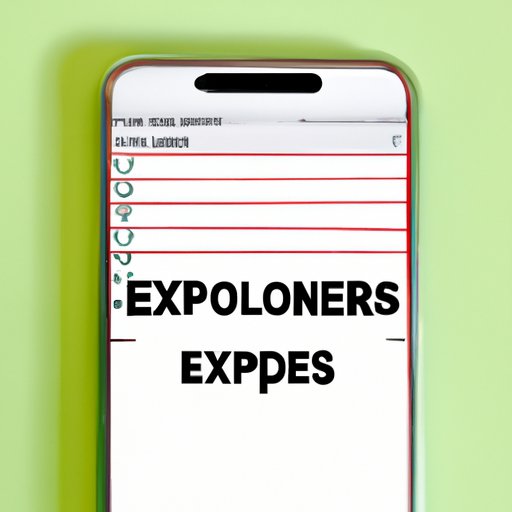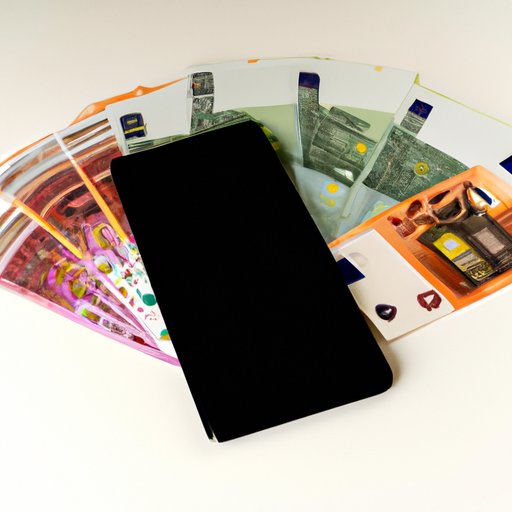
Introduction
Do you often wonder where your money goes each month? If you’re like most people, you probably have a rough idea of what you spend your money on, but you don’t know exactly where every dollar goes. Tracking your expenses is an essential part of financial planning and management. By doing so, you can identify areas where you’re overspending and take steps to control your expenses. In this article, we’ll explore 10 creative ways to track where your money goes each month and more, so you can take charge of your finances.
10 Creative Ways to Track Where Your Money Goes Each Month
There are several ways to track where your money goes each month. Here are ten creative ways to get started:
A. Use an expense tracker app
Expense tracker apps like Mint, PocketGuard, and YNAB (You Need A Budget) can help you keep track of your expenses and budget. These apps can link to your bank accounts and credit cards, so you can see your spending in real-time. They also categorize your expenses and provide personalized insights and suggestions to help you manage your money better.
B. Keep a daily spending log
Keeping a daily spending log is a manual way of tracking your expenses. You can use a notebook, spreadsheet, or an app like Spendee or DailyBudget to record your spending. Write down every expense you make, even small ones like coffee or snacks. Review your spending log at the end of each day to help you stay on track.
C. Cut back on unnecessary expenses
Analyze your spending to identify areas where you can cut back. For example, if you spend $5 per day on coffee, consider making coffee at home instead. If you eat out frequently, try cooking at home or brown bagging your lunch. Cutting back on unnecessary expenses can add up and help you save money.
D. Use cash instead of cards
Using cash instead of cards can help you control your spending. When you use cash, you’re more aware of how much money you’re spending and tend to spend less. Withdraw a set amount of cash each week or month and stick to your budget.
E. Set a weekly or monthly spending limit
Set a weekly or monthly spending limit for each category of expense, such as groceries, entertainment, and transportation. Stick to your limits to prevent overspending.
F. Review your bank and credit card statements regularly
Review your bank and credit card statements regularly to spot any unauthorized charges or errors. This habit also helps you track your spending and stay within your budget.
G. Track your expenses by category
Tracking your expenses by category helps you understand where you’re spending the most money. Categories can include rent/mortgage, utilities, groceries, dining out, transportation, entertainment, and more. By breaking down your expenses into categories, you can identify areas where you can cut back and adjust your budget accordingly.
H. Use a spreadsheet or budgeting software
Using a spreadsheet or budgeting software like Excel or Google Sheets can help you track your expenses and budget. These tools allow you to customize your spending categories, track your monthly income and expenses, and create graphs and charts to visualize your spending habits.
I. Use a system that works for you
Choose a system that works for you and stick to it. Some people prefer manual methods like a notebook or spreadsheet, while others prefer using an app to track expenses. Whatever method you choose, make sure it’s easy to use and fits your lifestyle.
J. Consider using a financial planner
A financial planner can help you create a budget, set financial goals, and manage your money effectively. They can also provide personalized advice and recommendations based on your unique financial situation.
Discovering the Hidden Expenses: How to Identify Where Your Money is Really Going
Hidden expenses can add up quickly and impact your overall financial picture. Here are some tips to identify where your money is really going:
A. Review monthly bills and subscriptions
Review your monthly bills and subscriptions to identify any services you’re paying for but not using. Cancel unused services to save money.
B. Look for small purchases that add up
Small purchases like snacks, drinks, and convenience items can add up over time. Identify areas where you can cut back on these types of expenses.
C. Identify recurring expenses
Identify recurring expenses like rent/mortgage, utilities, and subscription services. These expenses are fixed and should be factored into your budget.
D. Analyze spending patterns
Analyze your spending patterns to identify areas where you tend to overspend. For example, if you tend to overspend on dining out, consider setting a monthly limit for this category.
E. Use a budget or spending plan
Use a budget or spending plan to help you keep track of your expenses and stay on target with your financial goals. Your plan should include expenses for needs and wants, as well as savings and investments.
Tracking Your Expenses: The Benefits and How to Get Started
Tracking your expenses offers several benefits, including:
- Helping you stay within your budget
- Identifying areas where you can cut back on expenses
- Helping you reach your financial goals faster
To get started tracking your expenses, follow these steps:
A. Record your expenses
Record your expenses daily using an app, spreadsheet, or notebook. Make sure to categorize your expenses to help you identify areas where you’re overspending.
B. Set goals
Set financial goals, such as paying off debt, saving for a down payment on a home, or building an emergency fund. Use your expense tracking to help you stay on track and achieve your goals.
C. Plan ahead
Plan for irregular expenses like car repairs or medical bills. Having a plan in place helps you avoid taking on debt or dipping into your savings.
D. Be consistent
Consistency is key when it comes to tracking your expenses. Make it a daily habit, and you’ll find that it becomes easier over time. Plus, you’ll start seeing the benefits of your efforts in your bank account.

The Top Apps and Tools for Keeping Track of Your Money
Here are some of the most popular apps and tools for keeping track of your money:
A. Mint
Mint is a free app that helps you track your spending, bills, and investments. It categorizes your expenses and provides personalized tips and insights to help you manage your money.
B. PocketGuard
PocketGuard is a budgeting app that connects to your bank accounts and credit cards. It provides real-time alerts when you’re nearing your budget limits and suggests ways to save money.
C. YNAB (You Need A Budget)
YNAB is a budgeting app that helps you break the paycheck to paycheck cycle and save money. It encourages you to assign every dollar a job, budget for irregular expenses, and adjust your spending as needed.
Understanding Your Spending Habits: A Step-By-Step Guide
Understanding your spending habits is the first step to taking control of your finances. Here’s a step-by-step guide:
A. Identify your spending triggers
Identify what triggers you to spend money. For example, are you more likely to spend money when you’re stressed or bored?
B. Figure out your priorities
Figure out what’s most important to you and prioritize your spending accordingly. For example, if you value travel, make sure to include it in your budget.
C. Track your progress
Track your progress regularly to stay on target with your financial goals. Use an app or spreadsheet to make it easier.
D. Evaluate your habits regularly
Evaluate your expenses and habits regularly to identify areas where you can improve. Adjust your budget and spending habits as needed.
How to Use Budgeting to Keep Tabs on Your Money and Save for the Future
Budgeting is an effective way to keep tabs on your money and save for the future. Here are some basics:
A. Basics of budgeting
Budgeting involves creating a spending plan and allocating your money accordingly. Start by identifying your expenses, including needs and wants, and create categories for each.
B. Steps for creating a budget
To create a budget, follow these steps:
- Identify your income
- List your expenses
- Create spending categories
- Allocate your money
- Track your spending
C. Different budgeting methods
There are several budgeting methods, including the 50/30/20 rule, envelope budgeting, and zero-based budgeting. Choose a method that works for you and stick to it.
D. Tips for sticking to your budget
To stick to your budget, try these tips:
- Automate your savings
- Use cash instead of cards
- Stay focused on your goals
- Review your budget regularly
E. Benefits of budgeting
The benefits of budgeting include:
- Helping you save money
- Reducing financial stress
- Helping you reach your financial goals
Saving Money Made Simple: Tips and Tricks to Track Your Expenses and Increase Your Savings
Here are some tips and tricks to track your expenses and increase your savings:
A. Tips for reducing your expenses
Try these tips to reduce your expenses:
- Cut back on dining out
- Brown bag your lunch
- Use public transportation instead of driving
- Cancel unused subscriptions and services
B. Ways to increase your income
Consider these ways to increase your income:
- Get a side gig or part-time job
- Sell items you no longer need
- Ask for a raise or promotion
- Invest your money
C. How to set savings goals
To set savings goals:
- Identify what you’re saving for (e.g., a down payment on a home, emergency fund, retirement)
- Set a specific goal amount
- Create a timeline
- Track your progress regularly
D. Strategies for saving money
Use these strategies to save money:
- Automate your savings
- Set up a separate savings account
- Make saving a priority
- Reduce your expenses
E. Final thoughts
Tracking your expenses is an essential part of financial planning and management. By doing so, you can identify areas where you’re overspending and take steps to control your expenses. Use the tips and tricks outlined in this article to start tracking your expenses, reduce your spending, and increase your savings.
Conclusion
Tracking your expenses can be tedious, but it’s essential to achieving your financial goals. By reviewing where your money goes each month, you can identify areas for improvement, develop a budget, save more, and reduce your financial stress.





